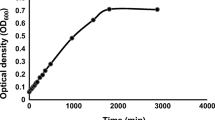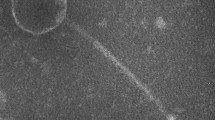Abstract
A bacteriophage active against a marine Aeromonas sp. was isolated from surface sediments of the North Pacific Ocean at 825 m depth. The sensitive Aeromonas sp. grew between 0° and 33°C but plaques were formed only between 0° and 23°C with a maximum zone of lysis at 5° to 12°C. The phage was rapidly inactivated at temperatures above 45°C. The characteristic plaque formation occurred only on media made with sea-water but some lysis was obtained in distilled water media supplemented with 0.085 M NaCl and 0.05 M MgCl2. Phage replication occurred in cultures of Aeromonas sp. growing under applied hydrostatic pressures of up to 200 atmospheres. Electron microscopy revealed that the phage has an hexagonal head 530 Å in diameter, a thin tail 1200 Å in length and a terminal base plate 400 Å in diameter.
Similar content being viewed by others
Literature cited
Adams, M. H.: The bacteriophages, 457 pp. New York: Interscience Publisher 1959.
Bradley, D. E., and D. Kay: The fine structure of bacteriophages. J. gen. Microbiol. 23, 553–563 (1960).
Brown, A. D.: Aspects of bacterial response to the ionic environment. Bact. Rev., 28,296–329 (1964).
Buttiaux, R., L. Coin, R. Trochon, et J. Moriamez: Le problème de la salubrité des huitres dans le centre ostréicole de la Basse-Seudre. Revue Hyg. Méd. soc. 3, 409–424 (1955).
Carlucci, A. F., and D. Pramer: An evaluation of factors affecting the survival of Escherichia coli in sea-water. IV. Bacteriophages. Appl. Microbiol. 8, 254–256 (1960)
Colwell, R. R., and J. Liston: Taxonomic relationships among the pseudomonads. J. Bact. 82, 1–14 (1961).
Elder, A. L., and F. W. Tanner: Action of bacteriophage on psychrophilic organisms. J. infect. Dis. 43, 403–406 (1928).
Feary, T. W., E. Fisher, Jr., and T. N. Fisher: Isolation and preliminary characteristic of three bacteriophages associated with a lysogenic strain of Pseudomonas aeruginosa. J. Bact. 87, 196–208 (1964).
Fildes, P., D. Kay, and W. K. Joklik: Divalent metals in phage production. In: The nature cf virus multiplication. Cambridge: University Press 1953 (Symp. Soc. gen. Microbiol. 2, 194–210).
Heden, C. G.: Effects of hydrostatic pressure on microbial systems. Bact. Rev. 28, 14–29 (1964).
Johnson, R. M.: Characterization of a marine bacteriophage. Bact. Proc. G 34, 21 (1966).
Kriss, A. E.: Marine microbiology, 536 pp. Edinburgh: Oliver & Boyd 1963 (Movskaja mikrobiolgija [glubokovodnaja]). Tr. from the Russ.
—, and E. A. Rukina: Bacteriophages in the sea. Dokl. Akad. Nauk SSSR 57, 833–836 (1947).
Landmann, O. E., H. T. Bausum, and T. S. Matney. Temperature-gradient plates for growth of microorganisms. J. Bact. 83, 463–469 (1962).
MacLeod, R. A.: The question of the existence of specific marine bacteria. Bact. Rev. 29, 9–24 (1965).
Rutberg, L.: On the effects of high hydrostatic pressure on bacteria and bacteriophage. I. Action on the reproduction of bacteria and their ability to support growth of bacteriophage T 2. Acta path. microbiol. scand. 61, 81–90 (1964a).
— On the effects of high hydrostatic pressure on bacteria and bacteriophage. II. Inactivation of bacteriophage. Acta path. microbiol. scand. 61, 91–97 (1964b).
— On the effects of high hydrostatic pressure on bacteria and bacteriophage. III. Induction with high hydrostatic pressure of prophage on E. coli at high pressure. Acta path. microbiol. scand. 61, 98–105 (1964c).
Shewan, J. M., W. Hodgkiss, and J. Liston: A method for the rapid differentiation of certain non-pathogenic asporogenous bacilli. Nature, Lond. 173, 208 only (1954).
Smith, L. S., and A. P. Krueger:Characteristic of a new Vibrio-bacteriophage system. J. gen. Physiol. 38, 161–168 (1954).
Solomon, L., P. Zeegen, and F. A. Eiserling: The effects of high hydrostatic pressure on coliphage T 4. Biochim. biophys. Acta 112, 102–109 (1966).
Spencer, R.: A marine bacteriophage. Nature, Lond. 175, 160–161 (1955).
— Indigenous marine bacteriophages. J. Bact. 79, 614 (1960).
— Bacterial viruses in the sea. In: Symposium on marine microbiology, pp. 350–365. Ed. by C. H. Oppenheimer. Springfield, Ill.: C. Thomas & Co. 1963.
Valentine, A. F., and G. B. Chapman: Fine structure and host-virus relationship of a marine bacterium and its bacteriophage. J. Bact. 92, 1535–1554 (1966).
—, P. K. Chen, R. R. Colwell, and G. B. Chapman: Structure of marine bacteriophage as revealed by the negative staining technique. J. Bact. 91, 819–822 (1966).
Zobell, C. E.: Marine microbiology: A monograph on hydrobacteriology, 240pp. Waltham, Mass.: Chronica Botanica Co. 1946.
—, and R. Y. Morita: Deep sea bacteria. Galathea Rep. 1, 139–154 (1959).
Author information
Authors and Affiliations
Additional information
Communicated by G.L. Voss, Miami
Rights and permissions
About this article
Cite this article
Wiebe, W.J., Liston, J. Isolation and characterization of a marine bacteriophage. Marine Biol. 1, 244–249 (1968). https://doi.org/10.1007/BF00347117
Accepted:
Issue Date:
DOI: https://doi.org/10.1007/BF00347117




